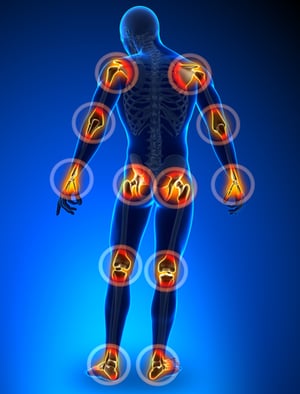The American Podiatric Medical Association reported in 2014 that according to a survey of more than 1,000 US adults, 77 percent had experienced foot pain at one or more times in their lives, but only a third of these people sought expert care by a podiatrist. The report went on to say:
 Foot pain can have a profound impact on quality of life. Half of all adults say that foot pain has restricted their activities—like walking, exercising, working, or playing with grandchildren—in some way. For those with chronic foot pain, that number jumps to 83 percent. People say they would exercise more (39 percent) and participate in more activities (41 percent) if it weren't for their foot pain.
Foot pain can have a profound impact on quality of life. Half of all adults say that foot pain has restricted their activities—like walking, exercising, working, or playing with grandchildren—in some way. For those with chronic foot pain, that number jumps to 83 percent. People say they would exercise more (39 percent) and participate in more activities (41 percent) if it weren't for their foot pain.
Much of this foot pain, along with spine and joint pain in the lower ligaments, is the result of standing for long periods in the workplace. Moreover, just as with the study referenced earlier, many of these workers do not report this pain to their supervisors at work.
However, they should. Back, foot, knee, and leg pain, especially if it is the result of standing for long periods, can negatively impact worker productivity. In other words, pain in the lower ligaments can have as much negative impact on our work lives as it can on our day-to-day lives.
Because of this, and because so many workers do not report their pain, employers must take it upon themselves to find out if their workers are suffering pain and endeavor to resolve it. Not only can they help alleviate this health problem for their workers, but they could also increase worker productivity, which can help the entire company.
One of the best ways to find out whether lower ligament pain is a problem in your facility is to send out a survey. It can be anonymous, and in some cases, that may prove to get better results. Among the questions to ask on the survey are the following:
· Over the past month, have you experienced foot, lower leg, knee, hip, or back pain at work?
· If so, has this pain persisted for more than a week? A month? Six months?
· On a scale of 1 to 5, with 5 being the most significant, how would you rate your pain?
· Do you believe this pain is work-related? If so, why?
· What type of shoes do you wear at work?
· What steps have you taken to help reduce the pain?
· Are you familiar with anti-fatigue mats?
· If so, do you believe anti-fatigue mats could help reduce your pain?
With the feedback, employers can determine if their workers, especially those who stand for long periods, need to stand on anti fatigue mats. The ultimate decision falls to the employer. However, if more than 25 percent of staff report they are experiencing leg pain on the job, that is a strong indication that anti-fatigue mats are needed.
For more information on mats that help reduce pain and improve worker productivity, contact Crown Matting Technologies at 800-628-5463 or send us an email.
Comments